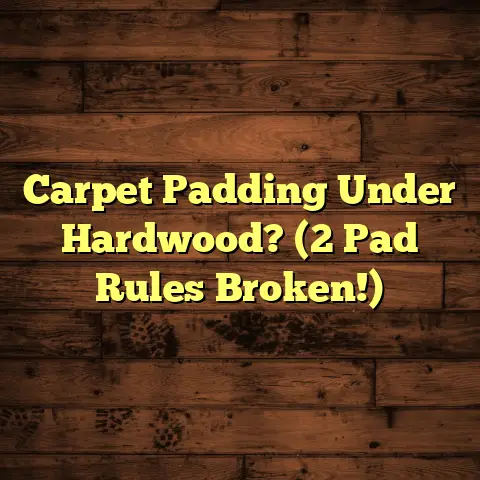How Is Bamboo Flooring Made? (7 Core Layer Facts!)
It’s a fascinating journey from stalk to stylish floor, driven by technological innovations that transform a sustainable resource into a durable and desirable option.
Let’s dive in and explore the 7 core layer facts you need to know!
Understanding Bamboo as a Material
First, let’s talk about the star of the show: bamboo itself.
It’s not a tree, but a grass – a giant, incredibly fast-growing grass!
Think about that for a second.
While hardwood forests take decades to mature, some bamboo species can grow several feet in a single day.
That’s why it’s considered a highly renewable resource.
There are over 1,600 species of bamboo (Source: American Bamboo Society), but only a few are commonly used for flooring.
- Moso Bamboo: The most popular choice, known for its strength and density.
- Ma Bamboo: Another strong variety, often used in construction.
The rapid growth cycle is what makes bamboo so sustainable.
We can harvest it without causing the same level of deforestation associated with traditional hardwood.
Plus, bamboo requires minimal pesticides and fertilizers, further reducing its environmental impact.
The Bamboo Harvesting Process
So, how do we get from a towering stalk of bamboo to usable material?
It all starts with harvesting.
The ideal age for harvesting bamboo for flooring is typically between 4-6 years.
At this age, the stalks have reached maturity and optimal density.
Harvesting is usually done manually, using machetes or saws.
The key is to cut the bamboo close to the ground, leaving the root system intact.
This allows the plant to regenerate quickly, ensuring a continuous supply of bamboo.
The geographical regions where bamboo is commonly harvested include:
- China
- Southeast Asia
- South America
The climate in these regions plays a crucial role in bamboo quality.
Warm, humid environments promote rapid growth and denser stalks.
Sustainable harvesting practices are paramount.
This includes selective cutting, replanting initiatives, and ensuring fair labor practices.
We want to use this resource responsibly, ensuring its availability for future generations.
Preparing Bamboo for Flooring
Once harvested, the bamboo needs to be prepared for manufacturing.
This involves several crucial steps:
Curing: Freshly cut bamboo contains a lot of moisture.
Curing involves allowing the stalks to dry naturally, often in the sun or in well-ventilated areas.
This process can take several weeks or even months.Drying: After curing, the bamboo undergoes kiln-drying to further reduce moisture content.
This is essential to prevent warping and cracking in the final product.
Removing impurities is another critical step.
The outer skin of the bamboo stalk contains sugars and starches that can attract pests and promote mold growth.
These are removed through a process of scraping and cleaning.
Proper preparation is vital for the durability and longevity of bamboo flooring.
If the bamboo isn’t dried and cleaned properly, the final product will be susceptible to damage.
Layering Process in Bamboo Flooring Production
Now we get to the heart of the matter: the layering process.
Bamboo flooring isn’t just a solid piece of bamboo.
It’s constructed with multiple layers for enhanced stability and performance.
Let’s break down the 7 core layers:
Top Layer: This is the surface you see and walk on.
It’s typically finished with several coats of a durable sealant, such as polyurethane or acrylic.
The top layer’s role is to provide:- Aesthetics (color, grain pattern)
- Scratch resistance
- Water resistance
- UV protection
Bamboo Veneer Layer: This is a thin layer of bamboo that’s applied beneath the top finish.
It’s carefully cut to showcase the natural beauty of the bamboo grain.
The veneer layer contributes to:- Visual appeal
- Even distribution of wear
- A smooth surface for the finish
Core Layer: This is the structural heart of the flooring.
It’s usually made of multiple layers of bamboo strips that are glued together under high pressure.
The core layer provides:- Strength and stability
- Resistance to impact
- Dimensional stability (preventing warping)
Backing Layer: This layer provides support and stability to the entire structure.
It’s often made of a similar material to the core layer, but may also include other materials like wood fibers.
The backing layer helps to:- Prevent cupping or bowing
- Provide a stable base for installation
- Reduce noise transmission
Adhesive Layer: This is the glue that holds all the layers together.
The type of adhesive used is crucial for both the performance and the environmental impact of the flooring.
Important factors:- Strength and durability
- Low VOC (Volatile Organic Compounds) emissions
- Resistance to moisture
Finish Layer: This is an additional protective coating applied to the backing layer.
It helps to:- Seal the bottom of the flooring
- Prevent moisture absorption from the subfloor
- Provide additional stability
Stabilizing Layer: This layer is often incorporated to improve the flooring’s performance under varying environmental conditions, especially humidity.
Stabilizing Layer helps in:- Minimize expansion and contraction
- Enhance overall durability
- Extend the lifespan of the floor
The specific materials and construction techniques used for each layer can vary depending on the manufacturer and the type of bamboo flooring.
Manufacturing Techniques
There are three primary manufacturing techniques used in bamboo flooring production:
-
Horizontal Bamboo Flooring: Bamboo strips are laid flat and glued together, showcasing the knuckles of the bamboo.
- Advantages: Traditional look, relatively inexpensive.
- Disadvantages: Softer than other types, may show wear more easily.
-
Vertical Bamboo Flooring: Bamboo strips are oriented on their edge and glued together, creating a more linear and uniform appearance.
- Advantages: More durable than horizontal, modern look.
- Disadvantages: Can be more expensive than horizontal.
-
Strand-Woven Bamboo Flooring: Bamboo strands are shredded, compressed, and glued together under extreme pressure, creating an incredibly dense and durable product.
- Advantages: Extremely durable, often harder than hardwood, unique grain pattern.
- Disadvantages: Most expensive type of bamboo flooring.
Here’s a quick comparison table:
The choice of manufacturing technique significantly impacts the quality, cost, and environmental footprint of the flooring.
Strand-woven bamboo, while more expensive, offers superior durability and a unique aesthetic.
Quality Control Measures
Quality control is essential to ensure that bamboo flooring meets industry standards and consumer expectations.
Manufacturers implement rigorous testing throughout the production process, including:
- Moisture Content Testing: Ensuring the bamboo is properly dried to prevent warping.
- Hardness Testing: Measuring the resistance to indentation and wear.
- Formaldehyde Emission Testing: Ensuring the adhesive meets safety standards.
- Dimensional Stability Testing: Assessing the flooring’s ability to withstand changes in temperature and humidity.
Several certifications can help you identify high-quality bamboo flooring:
- FloorScore: Ensures low VOC emissions. (Source: SCS Global Services)
- Forest Stewardship Council (FSC): Certifies that the bamboo is harvested from sustainably managed forests.
(Source: Forest Stewardship Council) - CARB Phase 2 Compliant: Ensures compliance with California Air Resources Board regulations for formaldehyde emissions.
(Source: California Air Resources Board)
Look for these certifications when shopping for bamboo flooring to ensure you’re getting a safe, durable, and environmentally responsible product.
The Role of Technology in Bamboo Flooring Production
Technological innovations have revolutionized bamboo flooring production, enhancing its quality, design options, and overall marketability.
Here are a few key advancements:
- Automated Machinery: Automated cutting, gluing, and finishing processes have increased efficiency and reduced waste.
- Eco-Friendly Adhesives: Low-VOC and formaldehyde-free adhesives have minimized the environmental impact and improved indoor air quality.
- Advanced Finishing Techniques: UV-cured finishes provide superior scratch resistance and durability.
- Digital Printing: Digital printing technology allows for the creation of realistic wood-grain patterns and custom designs on bamboo flooring.
These innovations have not only improved the quality of bamboo flooring but have also made it more accessible and affordable.
The use of technology has also enabled manufacturers to create a wider range of styles and finishes, catering to diverse consumer preferences.
Conclusion
So, there you have it – a comprehensive look at how bamboo flooring is made!
From the rapid growth of the bamboo plant to the sophisticated layering and manufacturing techniques, it’s a fascinating process.
Bamboo flooring is more than just a flooring option; it’s a statement about sustainability and innovation.
By understanding the 7 core layer facts and the manufacturing process, you can make an informed decision and choose a bamboo floor that’s both beautiful and environmentally responsible.
I hope this article has been helpful. Happy flooring!





